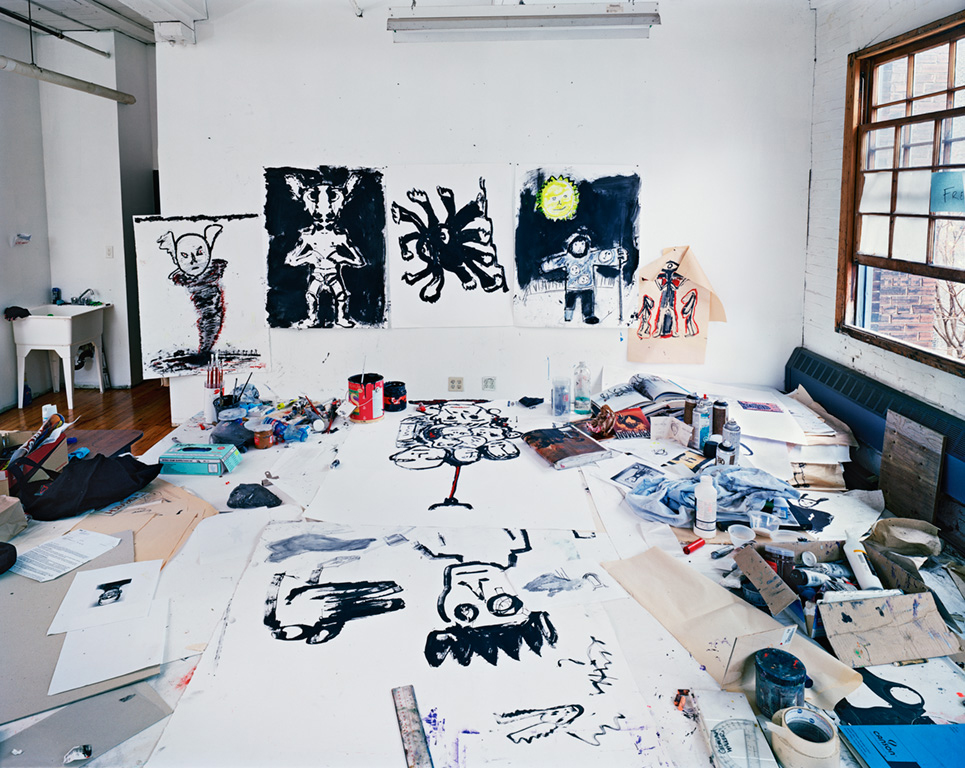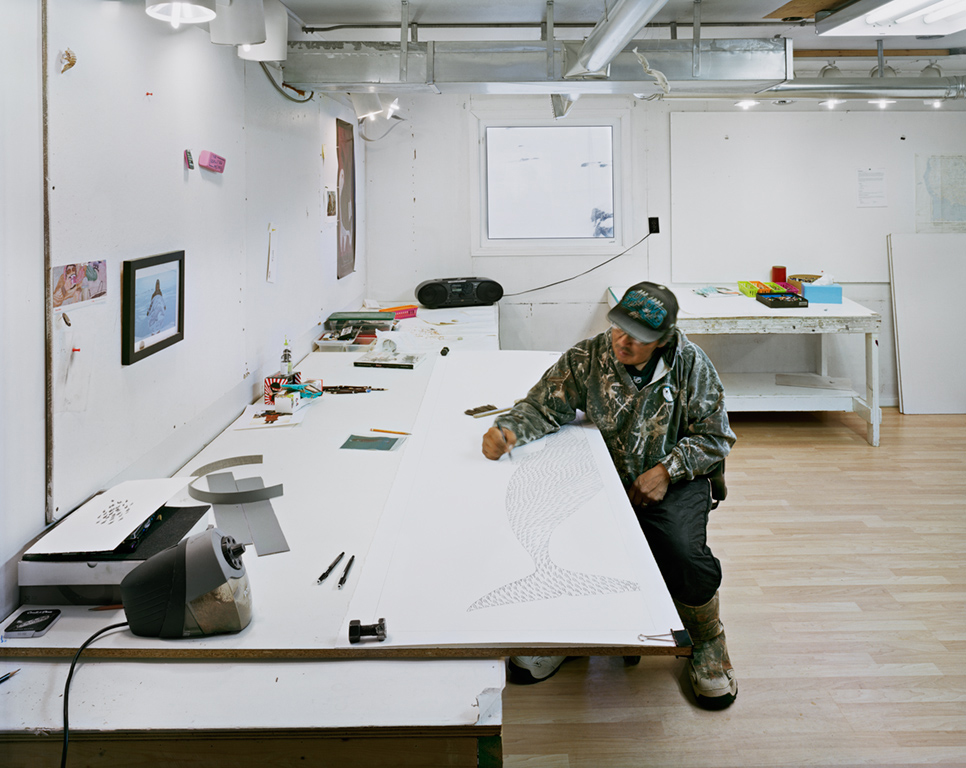Usually, viewers only get to see the objects that come out of an artist’s studio. But a new Canadian exhibition and book are offering the chance to take a look inside.
Starting June 17 at the Art Gallery of Hamilton, “Joseph Hartman: The Artist’s Studio” features large-scale photographs of studios belonging to some of Canada’s most well-known contemporary artists—including Robert Davidson, Mary Pratt, John Scott and Duane Linklater.
In all, over the past four years, Hartman has photographed more than 100 artist’s studios from coast to coast to coast. A wider view of his project will be available in a book, The Artist’s Studio, being released alongside the exhibition.
In this interview, Joseph Hartman talks about the project’s genesis, and the changing ways in which artists are working.
 Joseph Hartman, Shelley Adler, 2013. Digital chromogenic print. Courtesy of the artist and Stephen Bulger Gallery.
Joseph Hartman, Shelley Adler, 2013. Digital chromogenic print. Courtesy of the artist and Stephen Bulger Gallery.
Leah Sandals: You started your art practice by photographing large-scale construction sites and demolition sites. What led you, after that, to photograph the quieter, smaller, more private and individual space of the artist’s studio?
Joseph Hartman: It was an idea that I’d had in my head for a while.
Years ago—probably 8 to 10 years ago—I was at Chris Temple’s studio in Toronto photographing reproductions of his paintings, and this wall that he painted on had really interesting splotches on it, sort of an abstract form where he would do a little dab after getting his paint mixed up on his brush. So afterwards, I asked him if I could photograph that wall.
I took that one photo [at Chris Temple’s] and tried a few others, but none were as interesting as that first one. So I sort of sat on the idea for a few years as I was going through other projects.
Then, a few years later, I did a commercial job photographing John Scott’s studio. His gallerist had arranged a few pictures on the main working wall, and I remember when I was setting up for the photos, they wanted to move all the paint tables out of the way. After that shoot, I thought, if I had kept moving back and included more of the interesting objects in the studio—paint tables and random things—that the photos would have been a lot more interesting.
So that is where the idea started. It was still a few more years before I actually got going on the project. I think Kim Dorland was the first person I contacted, and he said yes. That was the beginning of 2013.
 Joseph Hartman, John Scott, 2014 (printed 2015). Chromogenic print ed. 1/9. Art Gallery of Hamilton, Purchase, Permanent Collection Fund, 2015.
Joseph Hartman, John Scott, 2014 (printed 2015). Chromogenic print ed. 1/9. Art Gallery of Hamilton, Purchase, Permanent Collection Fund, 2015.
LS: How did you decide to photograph more than 100 artist’s studios? And why are there people in a couple of the shots?
JH: Well, there are 124 studios in the series so far, and it’s still ongoing, because it’s still something I’m interested in.
The idea of travelling the country to photograph studios came pretty early in the project, because I thought, there are all these great artists whose work I really love, and I think they would have these great studio spaces. I tried to get as many as I could.
At the beginning of the project, I was interested in this idea of making a portrait of someone through the space that they occupy. I thought that would work well with artist’s studios because they are usually such personal spaces. There are no compromises as to what goes on the wall or what colour the space is.
As I progressed through the project, people started making their way into some of the photos. I work with a large-format camera, so it takes me a long time to get set up, and I would tell people to just keep working. “I can let you know when I’m ready to shoot, and you can step out.”
But then, I started finding really interesting photographs composed with the artists in them. I thought, I shouldn’t ignore an interesting photograph that has a person in it just because I started the project out one way.
 Joseph Hartman, Tim Pitsiulak, 2016. Digital chromogenic print. Courtesy of the artist and Stephen Bulger Gallery.
Joseph Hartman, Tim Pitsiulak, 2016. Digital chromogenic print. Courtesy of the artist and Stephen Bulger Gallery.
LS: What did you learn from seeing so many studios?
JH: The main thing I really noticed is that studios are all unique—they all have their own sort of personality.
Another thread that runs through them is they are all functional spaces. The artists have created spaces that work for them exclusively, basically, and if another artist came into that same space, they would rearrange things so that it works for them.
But there is a real beauty to the studio spaces. That’s why I loved doing this project—getting to see these very personal, intimate spaces and each space painting an interesting picture of the artist who works there.
 Joseph Hartman, Vanessa Maltese, 2016. Digital chromogenic print. Courtesy of the artist and Stephen Bulger Gallery.
Joseph Hartman, Vanessa Maltese, 2016. Digital chromogenic print. Courtesy of the artist and Stephen Bulger Gallery.
LS: One thing I thought about in looking at these photos was about the loss of studio space in some Canadian cities. For instance, in the time since you photographed Vanessa Maltese’s studio, that space stopped being a studio. What did you learn about the loss of studio space in your travels? What stories did you hear?
JH: Toronto and Vancouver were the two places where those stories were common.
The building that Vanessa Maltese was in, the rents were going up so much that she couldn’t afford to stay there. Howard Lonn and Joe Fleming were also some of the artists in Toronto having to move.
And that was the same in Vancouver: Rebecca Brewer and Tiziana La Melia mentioned they would be moving out shortly after I photographed their spaces.
I think it’s unfortunate. Right now there are a number of artists in Toronto moving to new areas that are cheaper for them, or moving out of the city to Hamilton. I recently spoke with someone moving to Stratford.
 Joseph Hartman, Duane Linklater, 2016. Digital chromogenic print. Courtesy of the artist and Stephen Bulger Gallery.
Joseph Hartman, Duane Linklater, 2016. Digital chromogenic print. Courtesy of the artist and Stephen Bulger Gallery.
LS: What about art that doesn’t fit in a studio practice? Or that is a post-studio practice, done on a laptop or in a community or in a camera? Most of the artists in your project focus on painting and sculpture—traditionally studio-based mediums. But that’s not the only kind of art that gets made nowadays.
JH: We are in an age where, because of digital technology, you can make art without a studio, you can have your photographs or 3-D prints or sculptures made offsite, and you don’t even have to have much of a studio, just a work desk.
More and more artists are moving and making that way. The reason I didn’t photograph any of those, though, is that I felt that act of making the artwork on site was very important to the photographs. That is why I stuck mainly to painters and sculptors.
 Joseph Hartman, Janet Werner, 2015. Digital chromogenic print. Courtesy of the artist and Stephen Bulger Gallery.
Joseph Hartman, Janet Werner, 2015. Digital chromogenic print. Courtesy of the artist and Stephen Bulger Gallery.
LS: And as you said, you still maintain a studio, too. Why do you still find it useful as a space for your own photo practice?
JH: I have a five-year-old daughter at home, and when she was quite young and not in school yet, it was good to have a place I could go and not have too many distractions.
I’ve always liked the idea of having a studio; it gives a bit of separation between life and work. I think for artists, it can be difficult to turn your mind off around thinking and making and doing the art—so it is nice to create some physical space between work and life.
 Joseph Hartman, Robert Davidson, 2016. Digital chromogenic print. Courtesy of the artist and Stephen Bulger Gallery.
Joseph Hartman, Robert Davidson, 2016. Digital chromogenic print. Courtesy of the artist and Stephen Bulger Gallery.
LS: What studios would you still like to shoot?
JH: There are a few artists whose studios, for one reason or another, I didn’t get the chance to photograph. Brian Jungen was one; I would love to photograph his studio. Takao Tanabe is another, as are Curtis Talwst Santiago and Christi Belcourt.
LS: Is there anything else you’d like people to know about these photos and the related exhibition?
JH: Well, they’re always best when you see the real prints. I print them quite large, 30 by 40 inches or 40 by 50 inches, so I really see them as this immersive experience—as being in the artist space when you are standing in front of the print.
“Joseph Hartman: The Artist’s Studio” runs June 17 to December 31 at the Art Gallery of Hamilton. The related book is being released June 20 by Black Dog Publishing.
 Joseph Hartman, Sara MacCulloch, 2015. Digital chromogenic print. Courtesy of the artist and Stephen Bulger Gallery.
Joseph Hartman, Sara MacCulloch, 2015. Digital chromogenic print. Courtesy of the artist and Stephen Bulger Gallery.
 Joseph Hartman, Shuvinai Ashoona, 2016. Digital chromogenic print. Courtesy of the artist and Stephen Bulger Gallery.
Joseph Hartman, Shuvinai Ashoona, 2016. Digital chromogenic print. Courtesy of the artist and Stephen Bulger Gallery.
 Joseph Hartman, Zachari Logan, 2016. Digital chromogenic print. Courtesy of the artist and Stephen Bulger Gallery.
Joseph Hartman, Zachari Logan, 2016. Digital chromogenic print. Courtesy of the artist and Stephen Bulger Gallery.
 Joseph Hartman, Claude Tousignant, 2015. Digital chromogenic print. Courtesy of the artist and Stephen Bulger Gallery.
Joseph Hartman, Claude Tousignant, 2015. Digital chromogenic print. Courtesy of the artist and Stephen Bulger Gallery.
 Joseph Hartman, Chris Cran, 2016. Digital chromogenic print. Courtesy of the artist and Stephen Bulger Gallery.
Joseph Hartman, Chris Cran, 2016. Digital chromogenic print. Courtesy of the artist and Stephen Bulger Gallery.
 Joseph Hartman, Mary Pratt, 2015. Digital chromogenic print. Courtesy of the artist and Stephen Bulger Gallery.
Joseph Hartman, Mary Pratt, 2015. Digital chromogenic print. Courtesy of the artist and Stephen Bulger Gallery.
 Joseph Hartman, Robert Youds, 2016. Digital chromogenic print. Courtesy of the artist and Stephen Bulger Gallery.
Joseph Hartman, Robert Youds, 2016. Digital chromogenic print. Courtesy of the artist and Stephen Bulger Gallery.
 Joseph Hartman, Valérie Blass, 2015. Digital chromogenic print. Courtesy of the artist and Stephen Bulger Gallery.
Joseph Hartman, Valérie Blass, 2015. Digital chromogenic print. Courtesy of the artist and Stephen Bulger Gallery.
 Joseph Hartman, Colleen Heslin, 2016. Digital chromogenic print. Courtesy of the artist and Stephen Bulger Gallery.
Joseph Hartman, Colleen Heslin, 2016. Digital chromogenic print. Courtesy of the artist and Stephen Bulger Gallery.
 Joseph Hartman, Gathie Falk, 2016. Digital chromogenic print Courtesy of the artist and Stephen Bulger Gallery.
Joseph Hartman, Gathie Falk, 2016. Digital chromogenic print Courtesy of the artist and Stephen Bulger Gallery.
 Joseph Hartman, Charles Meanwell, 2014. Digital chromogenic print. Courtesy of the artist and Stephen Bulger Gallery.
Joseph Hartman, Charles Meanwell, 2014. Digital chromogenic print. Courtesy of the artist and Stephen Bulger Gallery.
 Joseph Hartman, Attila Richard Lukacs, 2016. Digital chromogenic print. Courtesy of the artist and Stephen Bulger Gallery.
Joseph Hartman, Attila Richard Lukacs, 2016. Digital chromogenic print. Courtesy of the artist and Stephen Bulger Gallery.

 Joseph Hartman, Joseph Tisiga, 2016. Digital chromogenic print. Courtesy of the artist and Stephen Bulger Gallery.
Joseph Hartman, Joseph Tisiga, 2016. Digital chromogenic print. Courtesy of the artist and Stephen Bulger Gallery.







